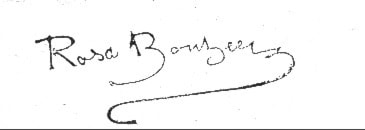Rosa Bonheur
Rosa Bonheur
32 artworks
French Realist painter, sculptor and animalier
Born 3/22/1822 - Died 1899


{"Id":333,"Name":"Rosa Bonheur","Biography":"\u003Cstrong\u003EBONHEUR, ROSA (1822-1899)\u003C/strong\u003E, French painter, was born at Bordeaux on the 22nd of March 1822. She was of Jewish origin. Jacques Wiener, the Belgian medallist, a native of Venloo, says that he and Raymond Bonheur, Rosas father, used to attend synagogue in that town; while another authority asserts that Rosa used to be known in common parlance by the name of Rosa Mazeltov (a Hebrew term for good luck, Gallic: Bonheur). She was the eldest of four children, all of whom were artists: \u003Ca href=\u0022/asp/database/art.asp?aid=2242\u0022 target=\u0022_blank\u0022 class=\u0022link\u0022\u003EAuguste\u003C/a\u003E (1824-1884) painted animals and landscape; Juliette (1830-1891) was honorably mentioned at the exhibition of 1855; Isidore, born in 1827, was a sculptor of animals. Rosa at an early age was taught to draw by her father (who died in 1849), and he, perceiving her very remarkable talent, permitted her to abandon the business of dressmaking, to which, much against her will, she had been put, in order to devote herself wholly to art. From 1840 to 1845 she exhibited at the salon, and five times received a prize; in 1848 a medal was awarded to her. Her fame dates more especially from the exhibition of 1855; from that time Rosa Bonheur\u0027s works were much sought after in England, where collectors and public galleries competed eagerly for them. What is chiefly remarkable and admirable in her work is that, like her contemporary, Jacques Raymond Brascassat (1804-1867), she represents animals as they really are, as she saw them in the country. Her gift of accurate observation was, however, allied to a certain dryness of style in painting; she often failed to give a perfect sense of atmosphere. On the other hand, the anatomy of her animals is always faultlessly true. There is nothing feminine in her handling; her treatment is always manly and firm. Of her many works we may note the following: \u003Cu\u003EPloughing in the Nivernais\u003C/u\u003E (1848), in the Luxembourg gallery; \u003Cu\u003EThe Horse Fair\u003C/u\u003E (1853), one of the two replicas of which is in the National Gallery, London, the original being in the United States; and \u003Cu\u003EHay Harvest in Auvergne\u003C/u\u003E (1855). She was decorated with the Legion of Honor by the empress Eugenie, and was subsequently promoted to the rank of officer of the order. After 1867 Rosa Bonheur exhibited but once in the salon, in 1899, a few weeks before her death. She lived quietly at her country house at By, near Fontainebleau, where for some years she had held gratuitous classes for drawing. She left at her death a considerable number of pictures, studies, drawings and etchings, which were sold by auction in Paris in the spring of 1900. (H. FR.)\u003Cbr\u003E\u003Cbr\u003E\u003Cstrong\u003E\u003Cu\u003ESource:\u003C/u\u003E\u003C/strong\u003E Entry on the artist in the \u003Ca href=\u0022http://33.1911encyclopedia.org/B/BO/BONHEUR_ROSA.htm\u0022 target=\u0022_blank\u0022\u003E1911 Edition Encyclopedia\u003C/a\u003E.\u003Cp\u003E","Awards":null,"HasAlbums":false,"HasPortraits":true,"HasRelationships":true,"HasArticles":false,"HasDepictedPlaces":true,"HasLetters":false,"HasLibraryItems":false,"HasProducts":false,"HasSignatures":true,"HasVideos":false,"HasMapLocations":true,"TotalArtworks":32}


